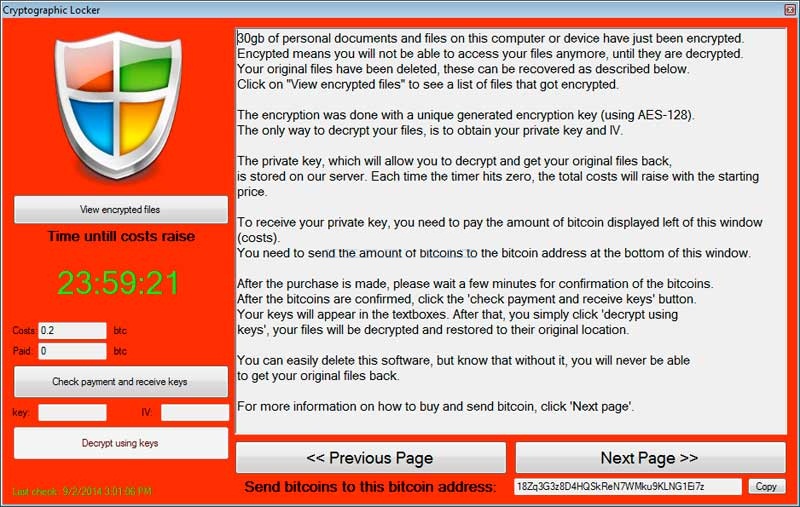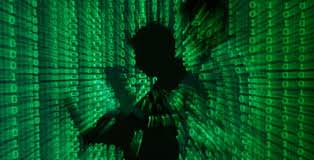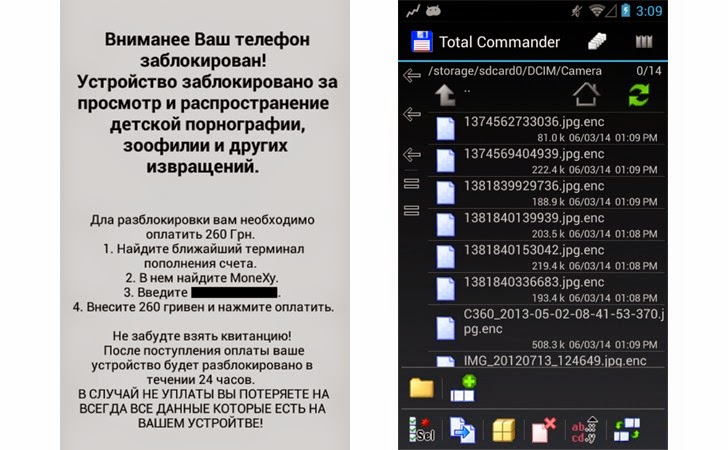
Following on from these [ FEDEX ] [ USPS ] posts describing the Spoofed FedEx and USPS ( and other delivery services from time to time) I will endeavour to keep up to date with a list of current sites involved in the spreading of this malware. I will also show the command used that day to obtain the malware. I will add each days new sites to the lists, but please remember that old sites are reused daily until taken down by their hosts. All the sites used in this malware spreading campaign are hacked / compromised sites.
The script tries the first in the list & then moves down until it gets a reply from the server. You never see the first downloaded file ( counter.js by searching on your computer, that is run directly from temp internet files ) Counter.js then downloads a different variant of counter.js which in turn downloads 01 first, then 02, then 03 until you get to 05. If any site doesn’t have the file, then it moves to the next site in the list for that particular file. Each site on the list has a full set of the files. but it is rare for the site delivering counter.js to actually download from itself, normally that downloads from a different site on the list. All the files ( apart from the original counter.js) pretend to be png ( image files). They are actually all renamed .exe files or a renamed php script listing the files to be encrypted. Counter.js contains the list of sites to download from, which includes many of the sites listed in the original WSF, JS, VBS or other scripting file and normally one or 2 extra ones. to get the second counter.js you need to change the &r=01 at the end of the url to &m=01 ( or 02-05). This second counter.js contains additional sites to download from which frequently includes sites from the previous days lists that are not already included in the WSF or first counter.js.
I only accidentally found out about the second /3rd /4th /5th counter.js when I made a mistake in manually decoding the original wsf file ( and the original counter.js) and mistyped/ miscopied the &r= and used &m= instead. Obviously it is a belt and braces approach to making sure the actual malware gets downloaded to a victim’s computer when urls or sites are known about and blocked by an antivirus or web filter service.
25 December 2016: ( Payload Security report )
3spension.com
minebleue.com
chaitanyaimpex.org
break-first.com
grancaffe.net
www.meizumalaysia.com
dreamoutloudcenter.org
megrelis-avocat.com
/counter/?a=1DtntZgmur6occ1CY29PJzvAzLsjCXMuyD&m=9488599&i=e5J5zaa6WhR1MYhBZ8L8Rmw2RWRVmbtna9Y_vLRIrGW2mVxU7SBYLhBH9Gj5Mr942yUp7kFWRWAOGtmJ5aqexWRDrTq_rGixe_a-gmVCMQ
/counter/?i=e5J5zaa6WhR1MYhBZ8L8Rmw2RWRVmbtna9Y_vLRIrGW2mVxU7SBYLhBH9Gj5Mr942yUp7kFWRWAOGtmJ5aqexWRDrTq_rGixe_a-gmVCMQ&a=1DtntZgmur6occ1CY29PJzvAzLsjCXMuyD&r=01
27 December2016: ( Payload Security report )
lacasadeicuochi.it
boardedhallgreen.com
www.memoodgetactive.det.nsw.edu.au
rebecook.fr
peachaid.com
kidsgalaxy.fr
baltasmenulis.lt
artss.org
/counter/?a=1HHDb3PbzDuGitWA7eW5oQFLzRjd1VzqhJ&m=3254807&i=Y5rzyqa6RhRlpx-dpPoqiXX2fW4GipPhNOTHtfBNJDBj6eEd6iZ3Yj9wAD7akn77R5LBqqvQvXIlyx_kYmBdyl0Bi12Qqds7
/counter/?i=Y5rzyqa6RhRlpx-dpPoqiXX2fW4GipPhNOTHtfBNJDBj6eEd6iZ3Yj9wAD7akn77R5LBqqvQvXIlyx_kYmBdyl0Bi12Qqds7&a=1HHDb3PbzDuGitWA7eW5oQFLzRjd1VzqhJ&r=01
28 December 2016: ( Payload Security report )
thanepoliceschool.com
chimie.iset-liege.be
partnersforcleanstreams.org
/counter/?a=1N1rEZQQ9Z3Ju6jggwn7hFU1jXytBTcK7r&m=8429816&i=LXEfbBQo_qDv_k77jrIae7y_BHSSQ_IZeneRTOoRmdDa4RlnJqaUKIl03HhN683DsUx-hkDi_OiCy0bOPjhZTiYm8RSQDBkfCerE
/counter/?i=LXEfbBQo_qDv_k77jrIae7y_BHSSQ_IZeneRTOoRmdDa4RlnJqaUKIl03HhN683DsUx-hkDi_OiCy0bOPjhZTiYm8RSQDBkfCerE&a=1N1rEZQQ9Z3Ju6jggwn7hFU1jXytBTcK7r&r=01
29 December 2016: ( payload Security report)
cobycaresfoundation.org
dev.zodia-q.com
shark1.idhost.kz
italysfinestdesign.it
salutgaudi.com
zodia-q.com
/counter/?a=13h8Y8z3WfiDFYG7jEWgsqZmPL94z22ca1&m=2365622&i=a5P5yqa6RhR1p80JYSnJbDP0I9KOXtIPtIhrFT4SHyIIqBAg-BghzAkZFkHS2tXw5C3mJYnrwuc1MpOfvGWZGd_STcfaml86P_kj5gA
/counter/?i=a5P5yqa6RhR1p80JYSnJbDP0I9KOXtIPtIhrFT4SHyIIqBAg-BghzAkZFkHS2tXw5C3mJYnrwuc1MpOfvGWZGd_STcfaml86P_kj5gA&a=13h8Y8z3WfiDFYG7jEWgsqZmPL94z22ca1&r=01
2nd version today ( Payload Security Report )
/counter/?=&i=a5P71qa6RhRlpLdtPLsJBpD0aKRuq7EtvIQrHyyE-zmVoG37HDoS-OmdfAXYY-Y0RtEcCwavHQyucNU4JL_PpGxvv0l-mxt00fo&a=16TqYh72RpopqiWR97WGMNtTGTazWFYBg1&r=01
/counter/?a=16TqYh72RpopqiWR97WGMNtTGTazWFYBg1&m=4831333&i=a5P71qa6RhRlpLdtPLsJBpD0aKRuq7EtvIQrHyyE-zmVoG37HDoS-OmdfAXYY-Y0RtEcCwavHQyucNU4JL_PpGxvv0l-mxt00fo
31 December 2016: ( Payload Security Report)
www.iblasoni.com
aventurarealestatedirectory.com
www.apogeoform.net
oytunidil.com
ocentsinus.com
sonja.ostrovanka.cz
instalaciondeairesplit.com
/counter/?a=1J9cj5Z7UvwkR9Tp1qywXBq994MFZ6dCLn&i=Y5p7yaa6RhRlPVwtx_0twhfOcSziOus6gsFi-6WQ9cGftnod2TtjVWJvU-_2nroNgi-lT8j6sF6rzL02lqFLiuQ20RDPqOBkTCSmGjp6NQ
/counter/?i=Y5p7yaa6RhRlPVwtx_0twhfOcSziOus6gsFi-6WQ9cGftnod2TtjVWJvU-_2nroNgi-lT8j6sF6rzL02lqFLiuQ20RDPqOBkTCSmGjp6NQ&a=1J9cj5Z7UvwkR9Tp1qywXBq994MFZ6dCLn&r=01
31 December 2016: update 2 ( Payload Security)
spiritdoula.net
www.yabaojiuhe.com
windycrestrental.com
maggieellisbusinessconsulting.com
pn-group.com
inflation.us
/counter/?a=16ehyeR9Nhrtgk4z2BrKZVJcKTFYe9Z1Ap&i=Y5r71qa6RhRlpLdvFNp4Tyf0O3puCoDDA0TLPwt-ZnjyqdV140NpvPnVGT2KeqxNu7AHi0Gk1WT6yYGkb0YxpcGpOaMzrto7
/counter/?i=Y5r71qa6RhRlpLdvFNp4Tyf0O3puCoDDA0TLPwt-ZnjyqdV140NpvPnVGT2KeqxNu7AHi0Gk1WT6yYGkb0YxpcGpOaMzrto7&a=16ehyeR9Nhrtgk4z2BrKZVJcKTFYe9Z1Ap&r=0





